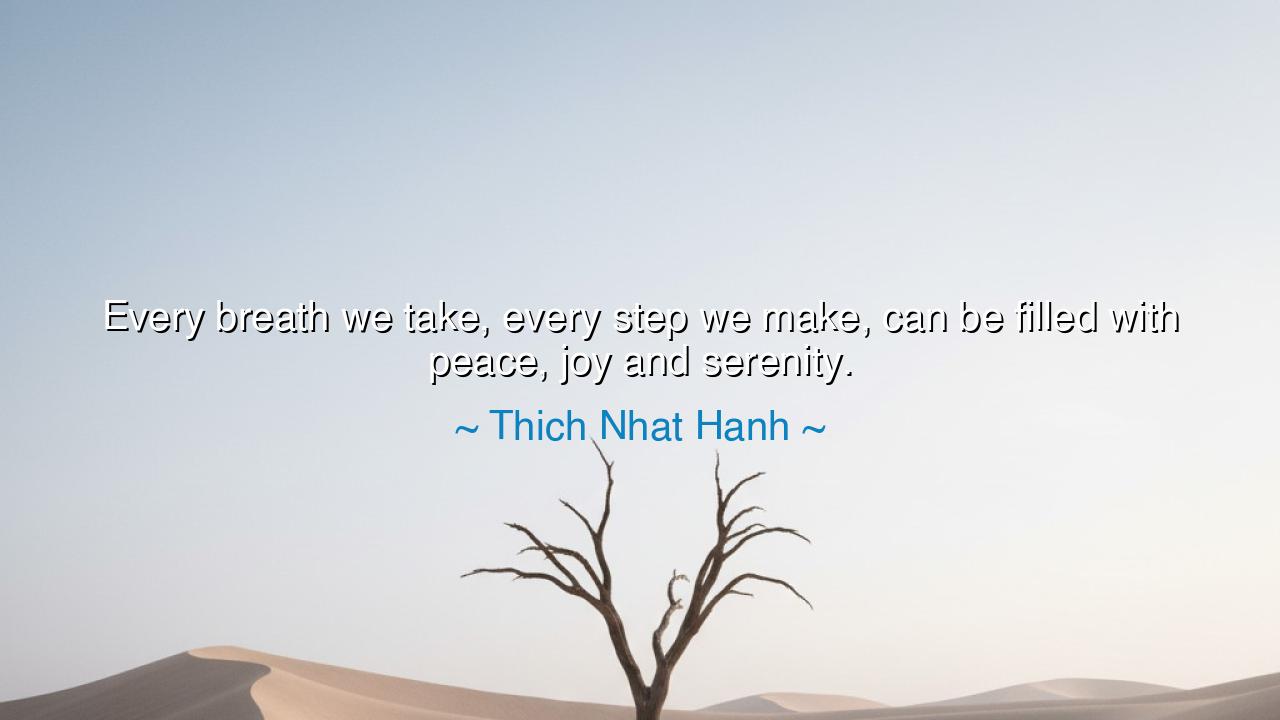
Every breath we take, every step we make, can be filled with






Thich Nhat Hanh, the gentle master of mindfulness and the poet of compassion, once uttered the luminous words: “Every breath we take, every step we make, can be filled with peace, joy and serenity.” In this teaching lies not merely advice, but a revelation: that peace is not distant, not something won only after long battles or mighty achievements. Instead, it is close, immediate, present in the rhythm of breath, in the motion of walking, in the smallest details of daily living. He shows us that peace, joy, and serenity are not prizes at the end of a road—they are the very road itself, if only we walk it with awareness.
When he speaks of “every breath,” he calls us to remembrance of life’s most essential act. The breath is constant, ceaseless, flowing within us whether we notice it or not. And yet, when taken with awareness, it becomes a wellspring of calm. A deep inhalation, a gentle exhalation—each can carry with it the weight of tranquility. To breathe with mindfulness is to return to the present moment, to free oneself from the chains of regret and the fever of future anxiety. In this, the master reminds us that peace is not outside us, but within, waiting in the simple act of breathing.
Likewise, when he speaks of “every step,” he points to the art of walking in awareness. Too often, we walk as if pursued, hurrying from one place to another, never feeling the earth beneath our feet. But if one walks slowly, with attention, then each step becomes a prayer, a meeting with the earth, a celebration of being alive. In Buddhist tradition, this is called walking meditation, and it transforms even the simplest journey into a sacred pilgrimage. The step is no longer only movement; it is peace made manifest.
History gives us examples of this teaching. Consider Mahatma Gandhi, who led his people not with weapons but with footsteps. His famous Salt March was not a mere protest, but a meditation in motion. Each step toward the sea was filled with resolve, dignity, and calm defiance, transforming the act of walking into an instrument of liberation. In this way, we see how steps filled with serenity and purpose can move nations, just as Thich Nhat Hanh tells us they can move the soul.
The teaching also rebukes our modern ways. In the age of haste, men and women often live in distraction, their breaths shallow, their steps hurried, their minds consumed by noise. They wait for peace to come after work is done, after burdens are lifted, after tomorrow arrives. Yet Thich Nhat Hanh calls us to a greater truth: peace is here, now, in the inhalation, in the step, in the present moment. To delay peace until tomorrow is to lose it forever, for only the present is real.
The deeper meaning is that life’s sacredness does not lie in distant heights, but in daily moments. To breathe with joy, to step with serenity, is to reclaim the holiness of the ordinary. The farmer in his field, the mother rocking her child, the student at his desk—all can find peace in the rhythm of breath and step. Nothing grand is required, only awareness, only presence. This is wisdom that transforms the smallest act into an eternal act.
So, O listener, take this lesson into your heart: let every breath be a thread of peace, and let every step be a seed of joy. When the storms of life rage, return to your breathing. When the burdens of the world weigh upon you, return to your walking. Make peace not a dream, but a practice; not an end, but a way. And in doing so, you will discover that serenity is not a distant summit, but a companion walking beside you always.
Thus, remember Thich Nhat Hanh’s wisdom: “Every breath we take, every step we make, can be filled with peace, joy and serenity.” Practice it daily, and your life shall become a quiet river, flowing steady, carrying you with calm strength toward all that is good and true.






AAdministratorAdministrator
Welcome, honored guests. Please leave a comment, we will respond soon